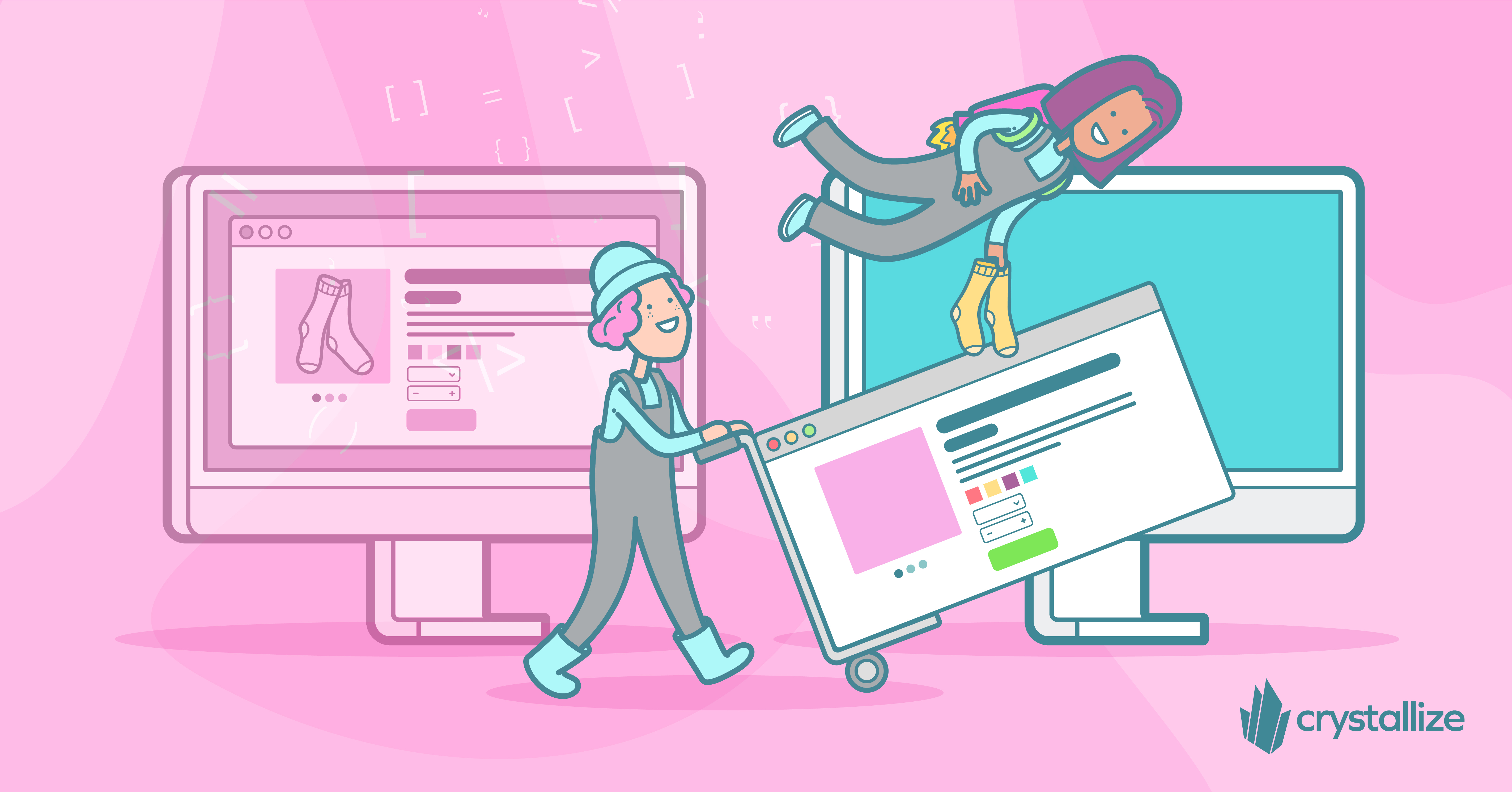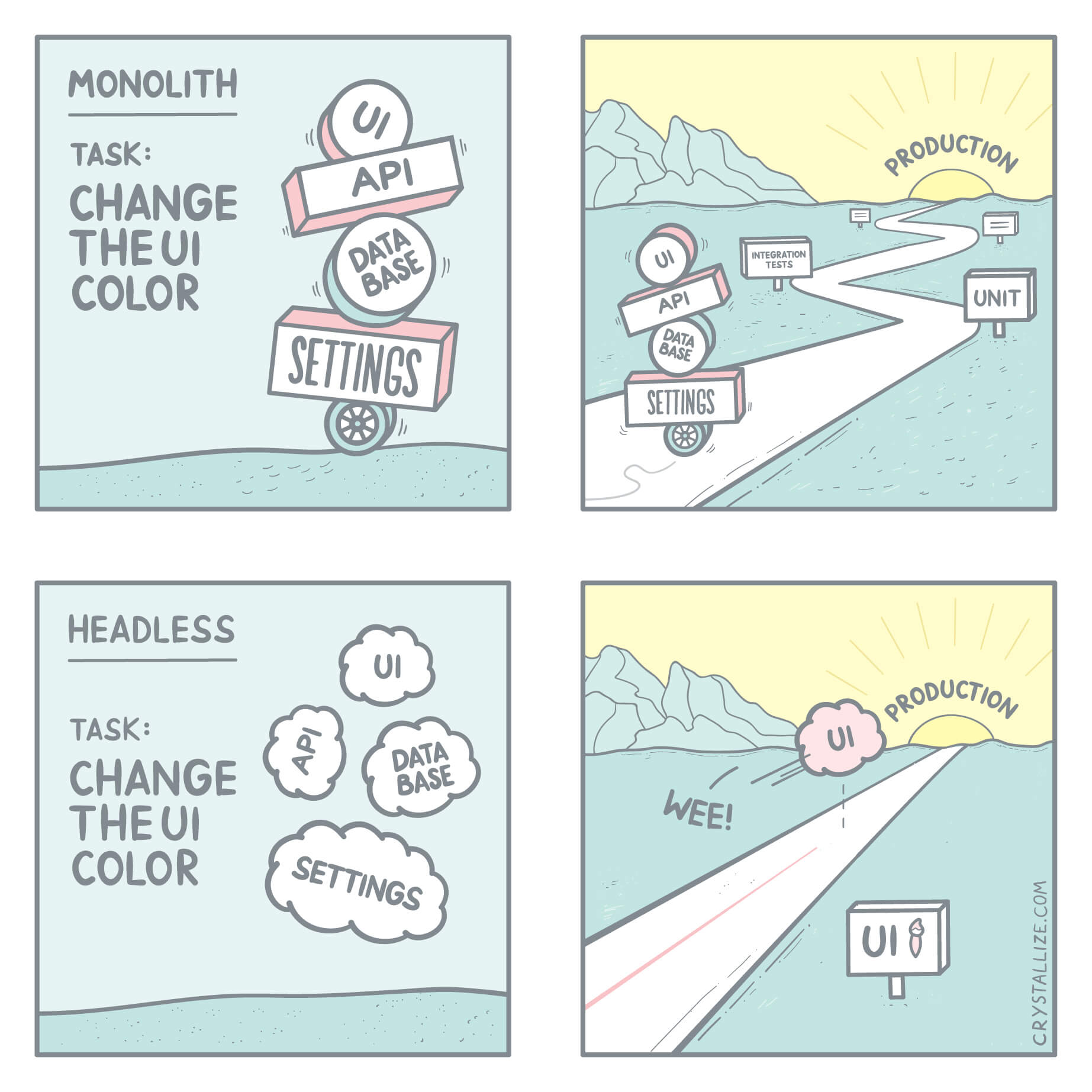Navigating the Shift: A Business Guide to Replatforming / Migrating to Headless Architecture
Replatforming to a headless architecture is becoming increasingly important for businesses that aim to stay competitive in the dynamic digital marketplace.

The headless approach is eating the web dev world… There is a good reason for it. Traditional monolith eCommerce platforms (like WordPress, Wix, Magento, Shopify, Drupal, etc.) often limit customization and agility due to their tightly coupled front and back systems.
Headless architecture, on the other hand, allows businesses to use different technologies for the front and back end, providing the freedom to create unique customer experiences without being constrained by the limitations of a monolithic architecture. Additionally, it allows for a best-of-breed approach to building your online store, where you can pick and choose the best solutions for your use case.
For many businesses, the decision to re-platform to a headless architecture is a technological upgrade and a strategic business move because it offers opportunities for enhanced agility, scalability, and a deeper engagement with customers through bespoke user experiences. This, more often than not, means a loyal audience and, ultimately, more sales.
How easy/hard it is to migrate to a new CMS/eCommerce/PIM platform depends heavily on your starting point, i.e., do you have a platform, and are you moving from a monolith or headless solution?
No platform/CMS? This should be easy because you are building a new digital experience for your audience and your team from scratch, which means there are no pre-defined restrictions your team should know.
Moving from monolith solution? Migration depends heavily on the solution you’ve used before. Migrating to a headless architecture involves significant technical challenges, including the re-architecture of the existing system, integration of APIs, and ensuring that all components work seamlessly together.
Changing headless platform? Again, it depends on the solution. Decupled front and back ends mean you can quickly adopt the exact content modeling in your new setting.
Transition requires meticulous and strategic planning, considering various factors, including technological limitations, integration complexities, future growth prospects, and budget constraints, making it much more difficult than anticipated.
However, there are general recommendations that will help you map out migration steps more easily.
The Imperative of Decision-Making in Replatforming
The decision to migrate to a headless architecture is critical, underscored by the necessity to meet contemporary digital demands and future-proof the business. Several key factors propel the drive toward headless architecture.
Enhanced Flexibility and Speed. Headless architecture allows businesses to rapidly adapt their front-end user experiences without reworking the entire system. This agility is crucial in the omnichannel era, where consumer preferences and digital technologies evolve swiftly.
Scalability and Performance. As businesses grow, their digital platforms must scale accordingly. Headless systems provide the scalability to handle increased traffic and transactions without compromising performance.
Customized User Experiences. The separation of front-end and back-end allows for the creation of personalized and contextually relevant user experiences, a key differentiator in the crowded digital marketplace.
Evaluate your platforms ' limitations before embarking on the replatforming journey.
Is the current system stifling innovation? Does it hinder the ability to implement changes or integrate new technologies quickly? Answering these questions will justify the need for a shift to a headless architecture.
Additionally, assess your future growth prospects and how a headless platform can support these ambitions. This includes considering the potential for international expansion, multi-channel strategies, and integrating emerging technologies such as AI and IoT.
Selecting the Right Headless Commerce Platform
Choosing the appropriate headless commerce platform is pivotal in the replatforming process. This decision must be informed by a deep understanding of the business's unique needs and future objectives. We've already discussed choosing in the linked blog post, so let's review just a couple of critical factors.
Customization and Flexibility. Look for a platform with extensive customization capabilities, allowing businesses to tailor the user experience and back-end functionalities to their specific requirements. Look for a platform that supports a wide range of front-end frameworks and provides robust API support for seamless integration with other systems and technologies.
Scalability. It is not just about handling increased traffic and transaction volumes as the business grows; it's also about adding new features, channels, and markets without significant rework.
Developer Ecosystem and Support. A robust developer ecosystem and comprehensive support are essential. They ensure that you can resolve issues quickly and keep your platform running smoothly.
Security and Compliance. With the increasing importance of data security and privacy, the platform must adhere to stringent security standards and compliance regulations.
Performance and Reliability. High performance and uptime ensure a reliable experience across all user touchpoints and should be non-negotiable for any eCommerce platform.
Cost and ROI. Consider the total cost of ownership, including initial setup, customization, maintenance, and scaling. Paying for a plan is just a fraction of the cost.
Image source: Monolith vs Headless: Part II.

Preparing for the Transition
Once the decision to replatform / migrate has been made and the appropriate platform selected, the next crucial phase is preparation. Start with stakeholder alignment. You should already have all relevant stakeholders, including business leaders, development teams, and marketing departments, aligned with the goals and vision of the replatforming project.
Conduct a thorough technical assessment to understand the capabilities and limitations of your current systems and how they will integrate with the new headless platform. Identify all potential risks associated with the replatforming, such as data breaches, technical failures, and performance issues. Understanding these risks upfront allows for better preparation and response strategies.
Next, develop a detailed project plan that outlines the scope, timeline, resource allocation, and key milestones. This plan should be realistic and account for potential challenges and dependencies.
Finally, a communication plan should be developed to keep all stakeholders informed. This includes regular updates on progress, challenges, and project scope or timeline changes. Then, train your teams to ensure they have the skills and knowledge to work with the new system.
A well-planned and executed preparation phase lays the foundation for a successful replatforming project.
Mastering Data Migration to Headless Systems
Data migration is critical to the replatforming process and demands meticulous planning and execution. Begin by mapping the existing data structure to the new platform. This process involves identifying all data sources, formats, and relationships. The goal is to ensure data is transferred accurately and efficiently without loss or corruption.
Develop a comprehensive migration strategy that includes data cleansing, backup procedures, and validation processes. The strategy should also outline how to handle large data volumes and complex data types and minimize downtime.
Rigorous testing is essential to ensure data integrity. This includes testing the migration process in a controlled environment and validating the data once it's migrated to the new system.
Once the migration is complete, provide ongoing support to address any issues. This includes monitoring system performance and ensuring data consistency.
Seamless Integrations with Existing Systems
Besides data migration, integrating the new headless platform with existing systems is vital for maintaining operational continuity and maximizing the value of the new architecture.
Leverage headless platforms' API-first nature for seamless integration. Ensure the APIs are robust, well-documented, and compatible with existing systems. Depending on business requirements, custom integration solutions may be necessary. This could involve developing new APIs or middleware to bridge the gap between old and new systems.
Thoroughly test all integrations to ensure data flows correctly and systems communicate effectively. Be prepared to optimize and adjust as needed to ensure smooth operation.
Prioritize UX/UI
A focus on UX/UI is essential for creating a compelling online presence in a headless commerce environment. Focus on creating a user experience that is intuitive, engaging, and tailored to your audience. Use the flexibility of headless architecture to build unique and personalized experiences.
What's more, the design must be ensured to be responsive and accessible across all devices and platforms. This inclusivity is key to reaching a wider audience.
Implement a process for gathering user feedback and continuously iterating on the design. This user-centric approach ensures that the platform evolves per user needs and preferences.
The Importance of Continuous Improvement
The replatforming journey doesn’t end with the launch of the new headless platform. Continuous improvement is key to leveraging the full potential of the new system. By that, we mean you should regularly evaluate the performance of the new platform. Look for opportunities to optimize speed, efficiency, and user experience.
Implement mechanisms to gather continuous user feedback. This insight is invaluable for making user-driven improvements and enhancements.
Embracing continuous improvement ensures your business remains competitive and can effectively respond to evolving market demands and technological trends.
Conclusion
Replatforming to a headless architecture represents a significant step forward in a business's digital transformation journey. While it offers numerous benefits regarding flexibility, scalability, and customer engagement, it requires a strategic, well-planned approach.
From decision-making and platform selection to data migration, integrations, and UX/UI design, each aspect of the replatforming process plays a critical role in ensuring a successful transition. By effectively managing risks and committing to continuous improvement, businesses can fully realize the potential of their new headless commerce platform, positioning themselves for sustained success in the digital marketplace.
Considering a move to headless? Give Crystallize a try.
Signing up is free, and you can join our Slack community if you need help setting up and moving your project.
Follow the Rabbit🐰

Reimagining eCommerce: the Story of Crystallize
Instead of building a better PIM, CMS, eCommerce, or order management service, we wanted to design an API layer you need to market and sell your products on any channel, at any scale, and in any way you want it. A perfect product story engine, if you will.

What Is Composable Commerce?
No longer a buzz term, composable commerce represents a paradigm shift in eCommerce architecture, fundamentally redefining how businesses approach their online shopping experiences. Given the benefits, it’s no wonder.

What Is Headless Commerce? Definition, Benefits, and When It’s Worth It
Headless commerce separates your storefront (front end) from back-end commerce logic, connected via APIs. It lets you ship faster, customize freely, and sell across web, apps, social, and in-store screens without back-end bottlenecks.

